A.1 - COMPLETED MISSIONS |
|
ANGOLA |
|
DEMOCRATIC PEOPLE'S REPUBLIC OF KOREA |
|
A.2 - MISSIONS IN PROGRESS |
|
BOSNIA AND HERZEGOVINA |
|
A.3 - MISSIONS PLANNED FOR JUNE |
|
AFGHANISTAN |
RWANDA |
IRAQ |
CONGO, REPUBLIC OF |
BURUNDI |
|
B.1 - NEW EMERGENCIES |
|||
COUNTRY |
TYPE OF DISASTER |
REQUEST |
FAO ACTION |
AFGHANISTAN |
FLOODS |
NO ASSISTANCE REQUESTED |
ASSESSMENT |
BANGLADESH |
CYCLONE |
NO ASSISTANCE REQUESTED |
NONE |
BURUNDI |
CIVIL STRIFE |
HAND TOOLS REQUESTED |
TCP FORMULATION |
CHINA |
FLOODS |
NO ASSISTANCE REQUESTED |
ASSESSMENT |
INDIA |
EARTHQUAKE |
NO ASSISTANCE REQUESTED |
ASSESSMENT |
JORDAN |
FROSTS (APRIL) |
TCP EMERGENCY ASSISTANCE REQUESTED (MAY) |
TCP FORMULATION; ASSESSMENT; INTERNATIONAL APPEAL |
MADAGASCAR |
LOCUSTS |
ECLO ASSISTANCE REQUESTED |
MULTIDONOR CONTROL PROGRAMME |
SIERRA LEONE |
CIVIL STRIFE |
HAND TOOLS REQUESTED |
EMOPS SUSPENDED |
B.2 - FOLLOW-UP ACTIONS ON PREVIOUS MONTH'S EMERGENCIES |
|||
COUNTRY |
TYPE OF DISASTER |
REQUEST |
FOLLOW-UP |
CHINA |
EARTHQUAKE |
NO |
- |
ECUADOR |
FLOODS |
YES |
ASSESSMENT UNDERWAY |
GAMBIA |
GROUNDNUT SEED SHORTFALL |
YES |
TCP AND NORWAY-FUNDED PROJECTS APPROVED; PROCUREMENT UNDERWAY |
IRAN |
EARTHQUAKE |
YES |
TCP PROJECT APPROVED; COMPREHENSIVE REQUEST ANTICIPATED |
IRAQ |
LOCUSTS |
YES |
ASSESSMENT COMPLETED; NO EMERGENCY CONFIRMED |
KAZAKHSTAN |
LOCUSTS |
YES |
TCP PROJECT APPROVED |
NIGER |
DROUGHT |
YES (SEEDS AND TOOLS) |
TCP PROJECT TO BE REVISED |
PHILIPPINES |
CIVIL STRIFE |
YES (NEEDS ASSESSMENT) |
AGRICULTURAL NEEDS ASSESSMENT MISSION FIELDED |
SOMALIA |
FLOODS |
YES |
ASSESSMENT TO BE FIELDED |
TANZANIA |
FLOODS |
YES |
TCP PROJECT BEING APPRAISED |
TONGA |
CYCLONE |
YES |
TCP PROJECT BEING APPRAISED |
UGANDA |
DROUGHT/CIVIL STRIFE |
YES |
TCP PROJECT BEING APPRAISED; AUSTRALIA-FUNDED PROJECT APPROVED |
CONGO, DEMOCRATIC REP. |
CIVIL STRIFE |
YES (NGO REQUEST FOR ASSESSMENT OF SEED REQUIREMENTS IN EASTERN AREA) |
|
FOLLOW-UP WITH NEW GOVERNMENT |
|||
B.3 - ASSESSMENTS AND PROCUREMENT ACTIVITIES |
|||
COUNTRY |
NATURE OF ACTIVITY |
||
ALBANIA |
ASSESSMENT OF EMERGENCY AGRICULTURAL NEEDS |
||
BOSNIA AND HERZEGOVINA |
MONTHLY MEETINGS OF UN/GOVERNMENT/DONOR NGO TASK FORCE |
||
CONGO, REPUBLIC OF |
ASSESSMENT OF GRASSHOPPER DAMAGE |
||
DEMOCRATIC PEOPLE'S REPUBLIC OF KOREA |
ASSESSMENT OF EMERGENCY AGRICULTURAL NEEDS |
||
GAMBIA |
PROCUREMENT MISSION FOR GROUNDNUT SEED |
||
GEORGIA |
ASSESSMENT OF EMERGENCY AGRICULTURAL NEEDS |
||
JORDAN |
ASSESSMENT OF FROST DAMAGE AND EMERGENCY AGRICULTURAL NEEDS |
||
PHILIPPINES |
ASSESSMENT OF EMERGENCY AGRICULTURAL NEEDS FOR EX-COMBATANTS, THEIR FAMILIES AND COMMUNITIES |
||
B.4 - UN CONSOLIDATED APPEALS |
|||
NONE IN MAY. |
|||
B.5 - PROJECTS APPROVED AND IN PIPELINE |
|||
17 COUNTRIES: |
|||
9 APPROVED PROJECTS + 2 REVISIONS APPROVED |
US$14 010 188 |
||
18 PIPELINE PROJECTS |
5 732 032 |
||
C.1 - JOINTLY-APPROVED WFP EMERGENCY OPERATIONS (EMOPS) |
||
ETHIOPIA |
US$11.6 MILLION |
560 000 BENEFICIARIES, 3 MONTHS |
TAJIKISTAN |
16.0 MILLION |
500 000 BENEFICIARIES, 12 MONTHS |
C.2 - GIEWS REPORTS |
||
SOMALIA - SPECIAL ALERT |
||
SUB-SAHARAN AFRICA - AFRICA REPORT |
||
ANGOLA - SPECIAL MISSION REPORT |
||
KENYA - CROP AND FOOD SUPPLY ASSESSMENT REPORT |
||
C.3 - EMERGENCY AGRICULTURAL REHABILITATION |
||
DEMOCRATIC PEOPLE'S REPUBLIC OF KOREA - BARLEY HARVEST FROM DOUBLE CROPPING PROGRAMME EXPECTED IN JULY |
||
MADAGASCAR - LOCUST-INFESTED AREAS TREATED |
||
SIERRA LEONE - SUPPLY OF FISHING GEAR, SEEDS AND TOOLS SUSPENDED |
||
IRAQ - AGRICULTURAL INPUTS PROCUREMENT UNDERWAY |
||
In November 1996, rinderpest, a highly contagious and often fatal livestock disease, was diagnosed among buffalo and eland in Nairobi National Park, Kenya. Afraid that the disease would spread across the border, the Government of the United Republic of Tanzania appealed for international assistance to prevent the country from reinfection after it had been free of the disease for 14 years.
In February 1997, at the request of Kenya, FAO, through EMPRES, set up a
meeting of veterinary officials and wildlife experts from the two countries to assess the
risk of the rinderpest spreading. The risk was judged to be high, aggravated by a drought
which caused herders to drive their livestock across borders in search of grazing.
Intensive surveillance and vaccination were undertaken by the veterinary and wildlife
teams of the two countries, in close collaboration with specialists from the Inter-African
Bureau for Animal Resources of the Organization for African Unity. One million emergency
vaccinations were delivered in a three-month period. FAO provided consultants and field
staff.
By the end of March 1997 the disease in Tanzania had been confined to four districts,
while in Kenya infection appears to have been restricted to the area to the south and
southeast of Nairobi.
Recently EMPRES has been successfully tackling a variety of animal diseases: examples
include eradication of contagious bovine pleuropneumonia from Botswana, and containment of
a damaging outbreak of African swine fever in C�te d'Ivoire. EMPRES is helping to develop
an effective vaccine against Newcastle disease which has devastating effects on poultry in
numerous countries of the world. This vaccine will be introduced as part of a package of
sustainable animal health and production practices currently being developed for use by
small-scale poultry producers.

Vaccination of cattle against rinderpest in Kenya
Drought gripped southern Africa in 1991/92 and 1994/95, seriously decreasing food production on both occasions. In 1991/92, cereal production was reduced by half, leaving subsistence farmers and their families in dire need. Some 18 million people faced starvation. However, effective early warning, rapid regional coordination and adequate international support resulted in a successful relief effort which effectively overcame widespread food shortages and the threat of famine.
As a result of the experience of the 1991/92 crisis, the impact of the
1994/95 drought emergency, while serious, was less devastating. Although the seasonal
rains began on schedule in October 1994, allowing planting, the rains soon tapered off to
a halt, leaving withered plants in parched fields. FAO's GIEWS and other FAO-assisted
national and regional early warning systems in the Southern African Development Community
(SADC) issued their initial warnings of impending drought in December.
In southern Africa, as elsewhere, drought areas are typically isolated and difficult to
reach; importing relief food from overseas, often through distant, inadequate ports, takes
time. Soon after the first warnings were issued, governments, donors and UN agencies began
meeting together to make plans for moving large-scale relief aid into the region should it
be necessary.
In January and February 1995, the impending onset of food difficulties as a result of
drought-induced crop losses in most countries of the subregion was confirmed. In March and
April, FAO and WFP experts arrived to assess the situation. The agencies jointly approved
an emergency operation to cover urgent relief needs. FAO issued a special alert, asking
the international community for relief assistance. In June, donors reacted to an appeal
for help by providing 1 million tonnes of food aid and other assistance. Starvation was
averted.
In another region frequently racked by drought, the Horn of Africa, FAO is helping to set
up a regional early warning system. The Organization is providing technical assistance and
training in risk mapping, remote sensing and early warning analysis for regional staff of
the Intergovernmental Authority on Development (IGAD) and national staff in its seven
member countries. FAO believes most farmers can take precautionary measures to guard
against drought; the assistance covers measures to mitigate the impact of drought through
better rangeland, water and farming system management and adoption of drought-resistant
crop varieties, as well as preparedness plans for the rapid mobilization of relief should
disaster strike.

Carrying bags of relief grain for refugees
When FAO receives an appeal for help against raging forest fires in developing countries, it responds by providing equipment, including communications systems, and technical assistance. FAO also advises countries on strategies to prevent forest fires and lessen their impact. For example, in Turkey forest fires are becoming an increasingly serious problem; they raged over huge coastal areas in 1994 and 1996, culminating in the catastrophic Gelibolu fire. FAO is advising the government on an overall fire prevention and control strategy.
Softwood plantations in Uganda are facing devastating wind-spread bush fires in the 1997 dry season as a result of prolonged drought and unusually high temperatures. Some 2 000 ha of the total 15 000 ha of industrial softwood plantations have already been destroyed, and further damage is expected. FAO is assisting in the development of a fire management strategy and a coordinated approach to fire prevention and suppression.

Fighting forest fire with simple technology
In 1992 the desert locust began to reproduce in great numbers in East Africa. International assistance was immediately requested, and FAO released funds to help fill the gap until donors could respond. Despite the quick reaction, in early 1993 locust swarms crossed the Red Sea, invading Saudi Arabia and Yemen. FAO sent experts to help organize and carry out large-scale aerial control, which was extended to Oman, Pakistan and India as the locusts spread during the summer.
Locust swarms appeared in the Sudan in June 1993 and cut a swath of destruction westwards across the continent. FAO issued warnings and forecasts, but many countries were caught unprepared. Major control operations were carried out in Mauritania, again with FAO funding until donor assistance could be organized. FAO also provided technical assistance to Mali, the Niger, Chad, Senegal, the Gambia and Guinea-Bissau as these countries were invaded from the east. As a result, the locust situation in the Sahel area is currently under control. However, in Madagascar, a dangerous infestation - the largest in 40 years - is causing serious damage to crops and vegetation. FAO is coordinating emergency assistance and mobilizing funds to suppress the swarms.
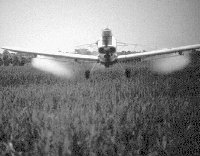
Aerial spraying of a sorghum crop to control locust infestation in Mali
In the first half of the 1990s, economic difficulties and the poor state of agriculture in the Democratic People's Republic of Korea reduced the country's food stocks to almost zero. Consequently, when widespread floods destroyed large crop areas and vital agricultural structures in 1995, a serious food emergency developed. In July 1996 flooding again reduced domestic food production and exacerbated the ongoing emergency. The country was obliged to appeal for international assistance. Furthermore, in June and July 1997 very little rain fell, and a severe drought resulted.
Throughout the emergency FAO has played a crucial role in alerting the
international community to the gravity and extent of the disaster and in promoting
responses to it. FAO has participated actively in the DHA-led UN consolidated appeals, the
issuance of several special alerts and the organization of special donors' consultations
and briefings at FAO headquarters in Rome. International response has been considerable;
food relief provided so far includes 70 000 tonnes in emergency assistance and
400 000 tonnes in programme assistance.
Under the aegis of the 1997/98 consolidated appeal for the Democratic People's Republic of
Korea, FAO called for the urgent funding of the most immediate requirements for the
agriculture sector, including support to increased cereal and vegetable production through
double cropping, the repair and rehabilitation of irrigation systems and the
rehabilitation of flood-affected land. In June 1997, FAO appealed on behalf of the
government for the urgent supply of fertilizer to boost rice production. FAO is also
providing technical assistance for the overall coordination of the emergency agricultural
rehabilitation programme.
Donors contributing to the agricultural relief and rehabilitation programme have included:
the European Community (EC), Norway, Switzerland, UNDP, Sweden, the Netherlands, World
Vision, CARE Norway and FAO's Technical Cooperation Programme. Support to the
double-cropping programme launched by the government enabled the introduction of barley
and vegetables on 37 000 ha.

Flooding of agricultural areas can cause food emergencies
On the southeastern coast of India, cyclones caused severe damage in October 1994, in November 1995 and in June, October and November 1996. The last of these devastated entire fishing villages, ruined banana and coconut plantations, killed 1 675 fisherfolk, wrecked 2 400 fishing boats and damaged a further 3 000, and led to the loss of thousands of fishing nets and other articles of equipment.
Because of a lack of radio communications, the timely warnings issued by
the Indian Meteorological Department reached neither the remote fishing villages of the
estuary and mangrove swamps nor the fishing boats at sea. The boats also lacked basic
life-saving equipment.
Beginning in two pilot villages, FAO is providing funds for technical advice, training and
equipment to ensure the reliable functioning of local systems for receiving and acting on
storm warnings, both in fishing villages and at sea, and to develop, test and implement
improved safety procedures at sea for small-scale fishing.
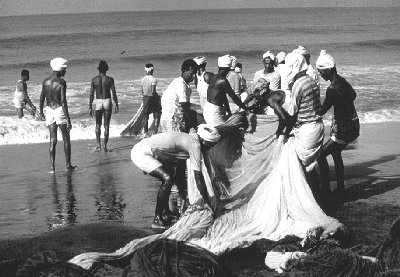
Nets of small-scale fishermen are often lost in violent storms
In September 1996, the eastern Caribbean suffered the full force of hurricanes Luis and Marilyn. The Organization of Eastern Caribbean States asked FAO to send a team to assess the damage and devise projects for rehabilitation in the agricultural and fisheries sectors. The team travelled extensively in the region and drew up a comprehensive programme.
Every year this region is hit by hurricanes, tropical storms and depressions. As a result, in addition to helping the region meet immediate needs, FAO agreed to fund a project to strengthen national and regional prevention and preparedness through technical assistance, equipment and training. The aim is to develop hurricane-resistant farming methods, crops and forestry techniques and to reduce the impact of hurricanes on the fishing industry.
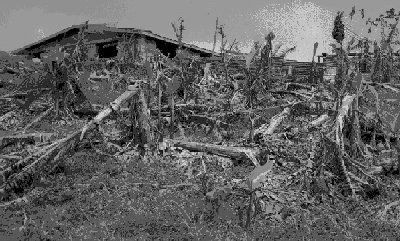
Destruction caused by a Caribbean hurricane
When large areas of Iraq's cereal and date-palm crops were attacked by pests in 1995, an insurmountable problem blocked control efforts: because of UN sanctions established after the war in the Persian Gulf, the country's planes were not allowed to fly over designated zones in the northern and southern parts of the country, so pesticides could not be sprayed on the fields in these areas.
Iraq appealed to FAO, as a neutral third party, to solve the problem and save the crops, which are staples of the Iraqi diet. With funding from several countries and DHA, FAO carried out a complicated emergency relief operation in May and June 1996. The operation involved obtaining approval from the United Nations Sanctions Committee to use non-Iraqi pilots, to import pesticides and to use helicopter spare parts held in storage to maintain the helicopters needed for the spraying.
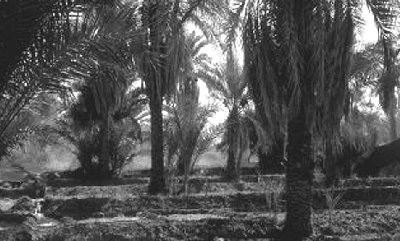
Date-palm plantations need protection from pests
Some 97 500 ha of cereals and more than 36 000 ha of date
plantation were sprayed in the "no-fly" zones. Flying time totalled some 430
hours. The value of crops saved as a result of the aerial spraying was estimated at US$7.3
million. A second spraying campaign, carried out in May and June 1997, resulted in yield
increases of wheat and dates estimated to be worth about US$35 million.
In December 1996, the United Nations Sanctions Committee approved an oil-for-food
programme allowing Iraq to export oil and import food and agricultural inputs. In the
northern part of the country, where the UN is managing imports under the programme, FAO
has been charged with the responsibility for assessment of agricultural requirements,
procurement of inputs and monitoring of inputs distribution. As of mid-1997, the value of
inputs procured and under delivery in the north amounted to US$18 million.
The eruption of Mount Pinatubo in the Philippines in June 1991 spewed out an estimated 6 600 million cubic metres of volcanic debris, hurling ash up to heights of 20 000 m. Even more destructive than the ash were the mud flows. Together, ash and mud devastated large agricultural areas around the volcano. Roads, bridges and irrigation systems were destroyed, and 40 000 families lost their homes.
Relief and rehabilitation efforts were initially concentrated on provision of new homesteads and livelihood opportunities for displaced families and on repairing essential infrastructure. In this context, an FAO mission helped to assess rehabilitation needs and identified three projects for creating livelihood opportunities - in agriculture, livestock and aquaculture - which were subsequently funded by the Organization. The aquaculture project helped to restore and increase production from fish ponds. Farmers were shown how to make their fish ponds economically viable with modern feed and management techniques.
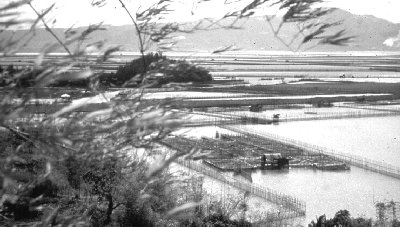
Aquaculture production offers livelihood opportunities in volcano-affected areas of the Philippines
Removal of the large deposits of ash and mud from agricultural land was time consuming, and the risk of secondary mud flows and flooding continued for some years after the eruption. With the return to normal conditions, in April 1997 FAO mounted an investment programming mission which identified programmes and projects for irrigation rehabilitation and watershed management, land rehabilitation and farming systems development, and income generation and livelihood support as priorities for sustainable recovery in the affected areas. These proposals are now being studied by potential financing institutions.
Rwanda was engulfed by a holocaust in 1994 which resulted in the death of 800 000 people, the flight of more than 2 million into neighbouring countries and the displacement of 380 000 in camps within the country. The conflict threatened to lead to widespread famine.
Since the beginning of the crisis in 1994 several FAO/WFP crop and food supply assessment missions have visited Rwanda. These missions assessed food supply difficulties, evaluated the food and nutritional status of the population and estimated seasonal requirements for cereal imports, including food aid. In addition to the joint FAO/WFP missions, FAO's Special Relief Operations Service fielded several missions to assess the most urgent needs for the agricultural sector. The most recent crop and food supply assessment mission, in June 1997, also undertook the assessment of agricultural input requirements. All the missions took into account the mass movements of Rwandan refugees to and from neighbouring countries and their prospects and needs.
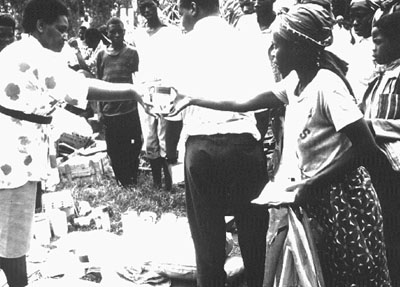
Distribution of vegetable seeds at a refugee centre in Rwanda
Following initial assessment by FAO in 1994 of requirements for the agricultural sector and a series of UN consolidated appeals, FAO obtained funds to start an emergency operation to supply desperately needed agricultural inputs to the rural populations affected by the crisis. The operation has three main components:
In the programme's first year of activity, more than 406 000
households in 95 percent of the country benefited. The value of agricultural production
resulting from the distribution of seeds and tools was calculated to be about US$11
million.
The emergency operation has grown into a large-scale agricultural relief programme
including measures for rehabilitation and reconstruction as well as immediate relief.
Donors funding the programme have included the World Bank, IFAD, the EC, Austria, Belgium,
Finland, France, Italy, Sweden, the Netherlands and the United Kingdom, as well as FAO
through its Technical Cooperation Programme and a special mission mounted by the
Director-General in December 1996.
The geographical region surrounding Lakes Victoria and Tanganyika, which includes parts of several countries in central Africa, has been the scene of prolonged civil and ethnic strife for many years. Because of the movements of affected populations across borders throughout the region, it has been necessary to view the crisis from a regional perspective, even though many actions have been taken at the country level. FAO has been active in a number of different and complementary areas, which include:
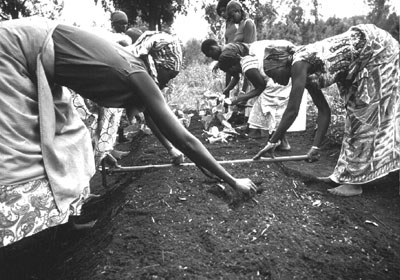
Technical advice on vegetable planting aids recovery in Burundi
In 1991, internal disturbances and the subsequent international embargo brought Haiti's already fragile economy to its knees. All major international assistance programmes came to a halt. Lack of imported fertilizers, seeds, spare parts for agricultural machinery and other essential inputs led to a widespread breakdown of agricultural services and food production.
From 1992 to 1994 FAO obtained substantial contributions from two major
food aid donors - Canada and the EC - for emergency assistance to destitute Haitian
farmers. The money was used to implement a series of agricultural relief and early
recovery projects to supply bean, maize and sorghum seeds as well as hand tools and other
inputs, and to restore input supply services. A special effort was made to boost local
seed production by farmers' organizations and commercial farms. This effort led to the
building up of a national seed industry. In addition, a network of community-owned retail
shops was set up, enabling farmers to access basic inputs at reasonable prices.
An independent evaluation of these projects concluded that they have provided the basis
for an exemplary evolution in food aid from relief to genuine recovery.
In December 1994, soon after the new government took office, an FAO mission visited Haiti
to assess basic agricultural rehabilitation and reconstruction needs. Its main proposals
concerned irrigation: rehabilitation of existing works and improvements to small and
medium-sized schemes. Other proposals covered watershed management, rural infrastructure
and fisheries. Several donors and financing institutions expressed interest, including the
Inter-American Development Bank (IDB), IFAD, UNDP, the EC and France. FAO was asked to
prepare an irrigation project for IDB and a project for intensified crop development for
IFAD. Both have been prepared and financing approval is expected shortly.
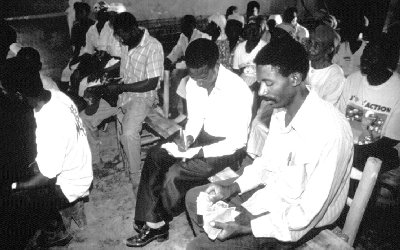
Farmers' meeting on organization of seed shops and agricultural input stores in Haiti
After the Paris peace agreements of October 1991, which followed two decades of conflict, Cambodia had to cope with 385 000 returnees from Thailand, 190 000 internally displaced persons and 40 000 people maimed by land-mines. Security problems persisted, with 10 to 15 percent of the country controlled by the Khmer Rouge and more than 5 million land-mines still in place. Agriculture was providing around half of a per caput gross domestic product (GDP) of less than US$200.
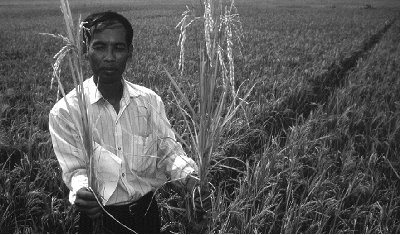
A Cambodian extension officer compares rice plants grown using
two different nutrient treatments under an FAO project to optimize use of donated
fertilizer
Ninety percent of farmland in Cambodia is devoted to rice. Fertilizers are essential to maintain and increase production. From 1991 to 1996, FAO implemented six fertilizer emergency aid projects with funds from the Netherlands, Sweden and Germany. The projects involved the distribution of more than 61 000 tonnes of fertilizer, representing about two-thirds of the total quantity of fertilizer officially imported into the country during the period. FAO also assisted in rebuilding the entry port's logistic capacities to handle large quantities of fertilizer; in training more than 150 extension workers and 35 000 farmers; and in providing equipment for the national soil laboratory. From 1992 to 1996 the projects increased paddy production by a total of more than 500 000 tonnes (equivalent to 300 000 tonnes of milled rice), reducing food aid needs accordingly.
When war disrupts agriculture, people go hungry. This is what happened in large parts of Bosnia and Herzegovina, where, by the end of 1993, the breakdown of markets and the supply system for seed, fertilizer and insecticides was almost total. To provide for the minimal needs of war-affected farmers for the 1995 autumn planting season, it was estimated that more than US$11 million were needed for seed, fertilizer and crop protection chemicals.
FAO provided about 1 100 tonnes of winter wheat seed to farmers in the most destitute area, the former Bihac pocket. The seed was taken into Bihac and distributed on UNHCR trucks, with the help of the Lutheran World Service and Bangladeshi peacekeeping troops.
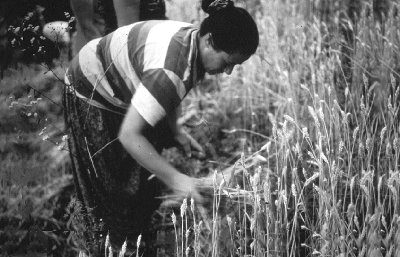
A farmer harvesting wheat raised with seed provided by
the FAO Emergency Programme for Bosnia and Herzogovina
In September 1995, the Netherlands and UNHCR agreed to contribute,
respectively, US$2.2 million and US$1.3 million to support the relief programme, in
partial response to a consolidated appeal for US$11 million. About 6 700 tonnes of
winter wheat seed were ordered and transported into Bosnia and Herzogovina, along with
needed fertilizer. The relief operation provided 90 percent of the emergency wheat seed
requirements identified by FAO for the 1995 autumn planting. This seed yielded about
63 000 tonnes of wheat for a hungry population.
Agricultural relief and early recovery activities continued in 1996 and 1997.
One of the most serious consequences of 18 years of civil war in Afghanistan has been disruption of agriculture and a sharp decline in food production. FAO, supported by funding from UNDP and other donors and with the support of NGOs active in the country, has been helping to restore sustainable agricultural production through a programme for integrated crop and livestock production.
The programme combines several separate earlier projects involving
agronomy, seed production, crop improvement, horticulture and plant protection, as well as
support for apiculture and sericulture. The programme functions as an extension service,
setting up farmers' field schools in some 80 districts in the country's main production
areas. Technical information is transferred to farmers at village level through
demonstration and training, with farmers selected from within the community taking the
lead.
In only two years the programme has achieved a great deal. For example, in 1995/96,
17 000 tonnes of quality seed - mainly wheat but also rice, maize, barley, pulses and
cotton - were produced and distributed by a countrywide network of supervised locally
contracted seed growers, set up under the programme. Crop improvement is also being
pursued through selection, testing and multiplication of disease-resistant varieties. In
1996 the programme established 66 new private fruit-tree nurseries in 19 provinces; a
further 97 are to be established in 1997.
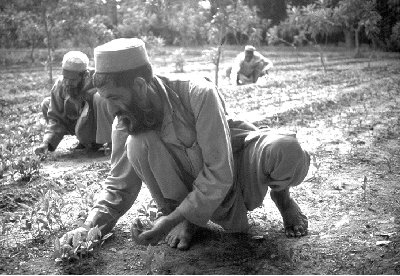
Technicians weeding seedlings at an FAO-supported fruit-tree nursery in Afghanistan
Another important area of activity has been restoration of animal health services. Afghans traditionally depend on livestock as an important source of food and income, but animal production had suffered during the war when veterinary services collapsed. Beginning in 1992, FAO has worked with other international organizations and NGOs to establish community-based veterinary field units in 219 of Afghanistan's 325 districts. The field units are staffed by more than 2 000 Afghan animal health workers. A survey conducted in seven districts after three years of operation showed that livestock mortality had been reduced by 22 to 60 percent. The financial benefit from decreased mortality averaged US$120 000 per district.